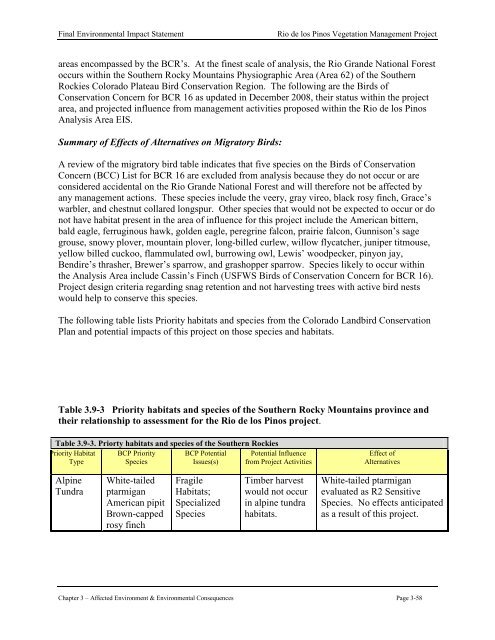Final Environmental Impact Statement Rio de los Pinos Vegetation ...
Final Environmental Impact Statement Rio de los Pinos Vegetation ...
Final Environmental Impact Statement Rio de los Pinos Vegetation ...
You also want an ePaper? Increase the reach of your titles
YUMPU automatically turns print PDFs into web optimized ePapers that Google loves.
<strong>Final</strong> <strong>Environmental</strong> <strong>Impact</strong> <strong>Statement</strong> <strong>Rio</strong> <strong>de</strong> <strong>los</strong> <strong>Pinos</strong> <strong>Vegetation</strong> Management Project<br />
areas encompassed by the BCR’s. At the finest scale of analysis, the <strong>Rio</strong> Gran<strong>de</strong> National Forest<br />
occurs within the Southern Rocky Mountains Physiographic Area (Area 62) of the Southern<br />
Rockies Colorado Plateau Bird Conservation Region. The following are the Birds of<br />
Conservation Concern for BCR 16 as updated in December 2008, their status within the project<br />
area, and projected influence from management activities proposed within the <strong>Rio</strong> <strong>de</strong> <strong>los</strong> <strong>Pinos</strong><br />
Analysis Area EIS.<br />
Summary of Effects of Alternatives on Migratory Birds:<br />
A review of the migratory bird table indicates that five species on the Birds of Conservation<br />
Concern (BCC) List for BCR 16 are exclu<strong>de</strong>d from analysis because they do not occur or are<br />
consi<strong>de</strong>red acci<strong>de</strong>ntal on the <strong>Rio</strong> Gran<strong>de</strong> National Forest and will therefore not be affected by<br />
any management actions. These species inclu<strong>de</strong> the veery, gray vireo, black rosy finch, Grace’s<br />
warbler, and chestnut collared longspur. Other species that would not be expected to occur or do<br />
not have habitat present in the area of influence for this project inclu<strong>de</strong> the American bittern,<br />
bald eagle, ferruginous hawk, gol<strong>de</strong>n eagle, peregrine falcon, prairie falcon, Gunnison’s sage<br />
grouse, snowy plover, mountain plover, long-billed curlew, willow flycatcher, juniper titmouse,<br />
yellow billed cuckoo, flammulated owl, burrowing owl, Lewis’ woodpecker, pinyon jay,<br />
Bendire’s thrasher, Brewer’s sparrow, and grashopper sparrow. Species likely to occur within<br />
the Analysis Area inclu<strong>de</strong> Cassin’s Finch (USFWS Birds of Conservation Concern for BCR 16).<br />
Project <strong>de</strong>sign criteria regarding snag retention and not harvesting trees with active bird nests<br />
would help to conserve this species.<br />
The following table lists Priority habitats and species from the Colorado Landbird Conservation<br />
Plan and potential impacts of this project on those species and habitats.<br />
Table 3.9-3 Priority habitats and species of the Southern Rocky Mountains province and<br />
their relationship to assessment for the <strong>Rio</strong> <strong>de</strong> <strong>los</strong> <strong>Pinos</strong> project.<br />
Table 3.9-3. Priorty habitats and species of the Southern Rockies<br />
Priority Habitat<br />
Type<br />
Alpine<br />
Tundra<br />
BCP Priority<br />
Species<br />
White-tailed<br />
ptarmigan<br />
American pipit<br />
Brown-capped<br />
rosy finch<br />
BCP Potential<br />
Issues(s)<br />
Fragile<br />
Habitats;<br />
Specialized<br />
Species<br />
Potential Influence<br />
from Project Activities<br />
Timber harvest<br />
would not occur<br />
in alpine tundra<br />
habitats.<br />
Effect of<br />
Alternatives<br />
White-tailed ptarmigan<br />
evaluated as R2 Sensitive<br />
Species. No effects anticipated<br />
as a result of this project.<br />
Chapter 3 – Affected Environment & <strong>Environmental</strong> Consequences Page 3-58
















